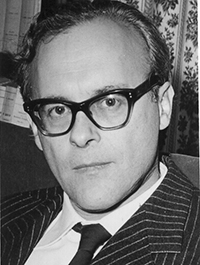
Vanni Mafera collection
Giovanni (Vanni) Mafera was born in Treviso in 1920. He obtained his Bachelor of Arts with Clemente Merlo at the Scuola Normale Superiore of Pisa in 1942.
He spent most of his career abroad: after winning a competitive selection for a position as cultural attaché, from the 1950s he worked as a University teacher and as the director of the Italian Cultural Institutes of Oslo, Copenhagen, Beirut, Belgrade, Luxembourg and Hamburg.
His long Danish experience led him to write, in collaboration with Knud Andersen, an Italian-Danish and Danish-Italian dictionary. After returning to Treviso he taught at the Da Vinci secondary school for science until the end of his career in the 1980s. He passed away in Treviso on 16 November 2008.
His extremely intense life unfolded through studying and teaching, civil and political commitments (including joining and leaving the radical party), travelling, environmental battles, and holding prestigious appointments at Italian liaison offices abroad.
He was part of the Disarmament movement in Italy, the Anti-vivisection movement, and the WWF’s Treviso division.
In addition to the Italian-Danish and Danish-Italian dictionary (Knud Andersen e Giovanni Mafera, Italiensk-dansk ordbog, Gyldendal, Copenaghen 1980, stampa 1999; Giovanni Mafera, Carla Avanza, Juul Madsen, Henning Juul Madsen, Dansk-italiensk ordbog, Gyldendal, Copenaghen 19982) we would also like to mention the following works by Vanni Mafera: Profilo fonetico-morfologico dei dialetti da Venezia a Belluno, Arti Grafiche Pacini Mariotti, Pisa 1957; Italia chiamò: sì, no!, Canova, Treviso 1999; Tre racconti per la pace, Piazza, Silea 2001; Saggi minimi di dialettologia veneta, Piazza, Silea 2006 (with Giovanni Roman).
Contents of the collection
The collection contains over 700 publications (including extracts and booklets), mainly on linguistics, Italian and Latin literature but also music, history and religion. There are also almost 3,000 photographs, over 500 letters and several dossiers of various documents recounting the places where he lived, and his professional and family relations.
There are also history and religion periodicals, cartography materials, mainly from Italian cities but also European and extra-European ones, photographs, correspondence and loose letters in other documents, dossiers containing works of colleagues or students, theme-specific files, postcards.
Many publications are in foreign languages, mainly Nordic and Serb-Croatian, but there are also texts in French, English, German and a number of booklets in Cambodian, many Norwegian or Danish editions of the classics of Italian literature.
There is a substantial number of dictionaries, especially of the Nordic languages, alongside Serb-Croatian and American slang dictionaries; there are also 5 copies of the dictionary written by Mafera.
Research instruments
Electronic inventory available in the Foundation archives and updated to 2019, available in printable version; list of extracts, list of documents from various sources, list of periodicals, list of letters.
Accessibility conditions
The collection may be browsed according to the methods set forth in the archive regulations.
Method of acquisition
Gift from Luigia Mafera, Giovanni Roman and Luigi Delogu in 2010; with later integrations from Luciana Picchio and Luigi Urettini in 2012, Franca Tessari in 2015.
